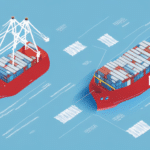Understanding the Basics of a Bill of Lading (BOL)
If you're involved in international trade, you've likely encountered the term Bill of Lading (BOL). A BOL is a crucial document that serves as proof of shipment and receipt of goods. In this article, we delve into the fundamental aspects of a BOL, its significance, various types, and guidelines on how to fill it out correctly.
What is a Bill of Lading (BOL)?
A Bill of Lading is a legal document issued by a carrier to a shipper, acknowledging that goods have been received on board for shipment to a specified destination. It functions as a receipt for the goods, a contract between the carrier and the shipper, and evidence of title to the goods.
Additionally, a BOL can serve as a document of transfer, allowing the holder to transfer the title of the goods to another party. This feature is particularly useful when goods are sold or traded during transit. The BOL typically includes information such as the type and quantity of goods, shipper and receiver details, and any special handling instructions.
The Purpose of a Bill of Lading (BOL)
The primary purpose of a BOL is to provide evidence of the contract of carriage and the transfer of title to the goods. It contains details about the shipment, including departure and arrival dates, shipper and consignee information, and a description of the goods. Upon arrival, the consignee must present the original BOL to the carrier to claim the shipment.
Beyond serving as contractual evidence and proof of title, the BOL acts as a receipt for the shipped goods. The carrier’s signature on the BOL confirms the receipt and loading of the goods, which can be used as proof of delivery in case of disputes or claims.
Types of Bill of Lading (BOL)
There are several types of BOLs, each suited to different shipping needs:
- Straight Bill of Lading: A non-negotiable document that names the consignee, ensuring only the specified party can claim the goods.
- Negotiable Bill of Lading: A transferable instrument that can be bought, sold, or traded while goods are in transit, allowing the holder to claim or transfer ownership without restrictions.
- Electronic Bill of Lading (e-BOL): A digital version that replaces traditional paper BOLs, enhancing efficiency by allowing electronic creation, signing, and transmission.
Other notable types include:
- Through Bill of Lading: Covers the entire journey of goods from origin to destination, even with multiple carriers involved.
- Air Waybill: Used for air freight shipments, detailing shipper, consignee, and goods information.
- Ocean Bill of Lading: Specific to ocean freight, including vessel and voyage details alongside standard shipment information.
Importance of Bill of Lading (BOL) in International Trade
The BOL is a legal record of the shipment, essential in mitigating risks such as loss, damage, or delays. It also serves as evidence of compliance with customs regulations for cross-border shipments.
Moreover, the BOL acts as a receipt from the carrier to the shipper, acknowledging receipt and responsibility for the goods' safe transport. In disputes or claims, the BOL can determine the carrier's liability.
Additionally, the BOL can function as a negotiable instrument in trade finance, allowing it to be used as collateral for loans or payment for goods, thereby facilitating smoother financial transactions in international trade.
Elements of a Bill of Lading (BOL)
A typical BOL includes the following elements:
- Shipper and consignee information
- Carrier details
- Description of the goods
- Date and place of shipment
- Shipping method and terms
- Freight charges
- Signed authorization by the shipper and/or carrier agent
Additional information may include the shipment's weight and dimensions, the number of packages, and any special handling instructions, ensuring the carrier can manage the goods appropriately.
The BOL also serves as a legal document establishing proof of ownership and transfer of goods, which is crucial in resolving disputes or claims related to shipment damages or losses.
How to Fill Out a Bill of Lading (BOL)
Accurately completing a BOL is vital for timely delivery and avoiding disputes. Follow these steps:
- Identify Shipper and Consignee: Ensure all information is accurate.
- Describe the Goods: Provide detailed descriptions to avoid confusion.
- Indicate Transportation Mode and Payment Terms: Specify how the goods will be transported and the terms of payment.
- Sign and Date: Authenticate the document with the necessary signatures and dates.
Remember, the BOL is a legal document outlining the shipment's terms and conditions. Any errors can lead to additional fees or legal disputes, so double-check all information before submission.
Common Mistakes to Avoid When Filling Out a Bill of Lading (BOL)
To prevent discrepancies, avoid the following common mistakes:
- Incorrect Consignee Information: Ensure the consignee's details are accurate.
- Incomplete Descriptions of Goods: Provide comprehensive descriptions to prevent misunderstandings.
- Incorrect Shipping Terms: Misstating terms can lead to increased costs or delays.
- Missing Signatures: Ensure all required signatures are included to avoid delivery delays.
Always ensure the BOL is fully and accurately completed to prevent shipment delays and additional costs. Double-check all entries before submission to maintain smooth shipping operations.
Electronic Bill of Lading (e-BOL) vs. Paper Bill of Lading
e-BOLs offer several advantages over traditional paper BOLs, including greater efficiency, cost-effectiveness, and reduced paperwork. Unlike paper BOLs, which require physical printing and delivery, e-BOLs are processed and shared electronically, minimizing manual handling and the risk of loss.
Furthermore, e-BOLs enhance transparency and simplify compliance with regulatory requirements. They can be easily tracked and monitored through digital systems, providing real-time updates and reducing miscommunication risks. Secure digital storage also eliminates the need for physical space and decreases the likelihood of document loss or damage.
Key Differences Between a Straight and Negotiable Bill of Lading
A Straight BOL is non-negotiable, naming the consignee and ensuring only they can claim the goods. In contrast, a Negotiable BOL can be transferred to other parties during shipment and used as collateral for financing.
Negotiable BOLs also serve as legal documents of title, granting the holder the right to take possession of the goods upon arrival. This is particularly beneficial in international trade, where buyers may not inspect goods before shipping. Additionally, negotiable BOLs can be endorsed to third parties, such as banks, to secure payments.
Liability and Responsibility under the BOL
The carrier is responsible for the goods during transit, ensuring their proper care, safety, and timely delivery. Meanwhile, the shipper must ensure proper packaging and labeling to prevent transportation damage. Any loss or damage is typically the carrier's responsibility, provided the shipper has met all packaging and labeling requirements.
Carrier liability is usually limited to a specified amount per package or unit of weight as outlined in the BOL. Shippers can declare a higher value for their goods and pay additional fees to increase the carrier's liability limit. It's advisable for shippers to carefully review and understand these clauses to protect their interests.
Examples of Common BOL Scenarios and How to Handle Them
Common scenarios involving BOLs include lost, damaged, or delayed shipments. In cases of loss or damage, the carrier is responsible for reimbursing the shipper for the goods' value. For cancellations or delays, the carrier must notify the shipper, and both parties should collaborate to resolve the issue effectively.
The Role of Banks in the BOL Process
Banks play a pivotal role in the BOL process, especially in financing. They facilitate payments between buyers and sellers, verify the authenticity of BOLs, and release BOLs to consignees once financial transactions are completed. This involvement ensures secure and efficient financial dealings in international trade.
How to Resolve Disputes Arising from the BOL
When disputes arise from a BOL, the involved parties should first attempt to resolve the issue through direct discussions. If negotiations fail, engaging a mediator or arbitrator can help facilitate a resolution. As a last resort, parties may take the matter to court to settle the dispute legally.
Conclusion: Understanding the Basics of a Bill of Lading is Crucial for International Trade
A Bill of Lading is an essential document in international trade, serving as proof of goods receipt, evidence of carriage contracts, and ownership documentation. Mastering the BOL's fundamental elements, accurate completion, various types, and the roles of different parties involved is vital for avoiding delays, disputes, and financial losses in global shipping.
For more detailed information on shipping documents and international trade compliance, visit the ShipScience Resources.






















